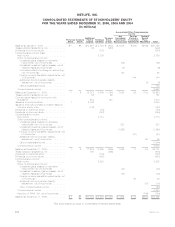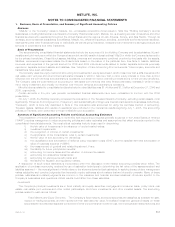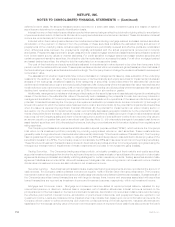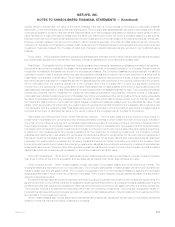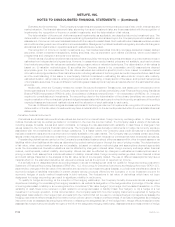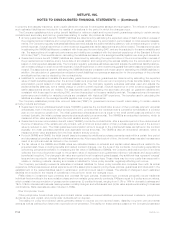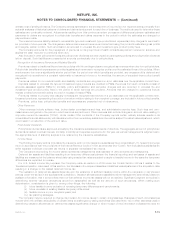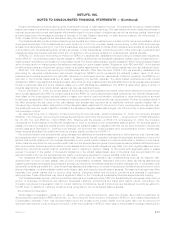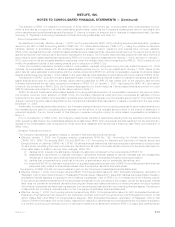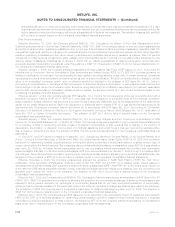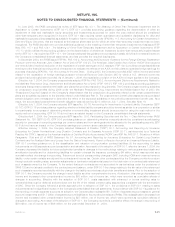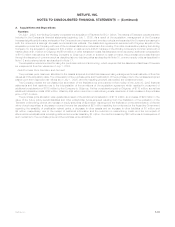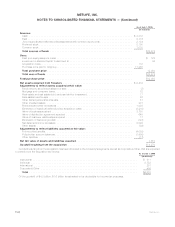MetLife 2006 Annual Report Download - page 97
Download and view the complete annual report
Please find page 97 of the 2006 MetLife annual report below. You can navigate through the pages in the report by either clicking on the pages listed below, or by using the keyword search tool below to find specific information within the annual report.to property and casualty insurance, such unpaid claims are reduced for anticipated salvage and subrogation. The effects of changes in
such estimated liabilities are included in the results of operations in the period in which the changes occur.
The Company establishes future policy benefit liabilities for minimum death and income benefit guarantees relating to certain annuity
contracts and secondary and paid up guarantees relating to certain life policies as follows:
• Annuity guaranteed death benefit (“GMDB”) liabilities are determined by estimating the expected value of death benefits in excess of
the projected account balance and recognizing the excess ratably over the accumulation period based on total expected assess-
ments. The Company regularly evaluates estimates used and adjusts the additional liability balance, with a related charge or credit to
benefit expense, if actual experience or other evidence suggests that earlier assumptions should be revised. The assumptions used
in estimating the GMDB liabilities are consistent with those used for amortizing DAC, and are thus subject to the same variability and
risk. The assumptions of investment performance and volatility are consistent with the historical experience of the Standard & Poor’s
500 Index (“S&P”). The benefits used in calculating the liabilities are based on the average benefits payable over a range of scenarios.
• Guaranteed income benefit (“GMIB”) liabilities are determined by estimating the expected value of the income benefits in excess of
the projected account balance at any future date of annuitization and recognizing the excess ratably over the accumulation period
based on total expected assessments. The Company regularly evaluates estimates used and adjusts the additional liability balance,
with a related charge or credit to benefit expense, if actual experience or other evidence suggests that earlier assumptions should be
revised. The assumptions used for estimating the GMIB liabilities are consistent with those used for estimating the GMDB liabilities. In
addition, the calculation of guaranteed annuitization benefit liabilities incorporates an assumption for the percentage of the potential
annuitizations that may be elected by the contractholder.
• Liabilities for universal and variable life secondary guarantees and paid-up guarantees are determined by estimating the expected
value of death benefits payable when the account balance is projected to be zero and recognizing those benefits ratably over the
accumulation period based on total expected assessments. The Company regularly evaluates estimates used and adjusts the
additional liability balances, with a related charge or credit to benefit expense, if actual experience or other evidence suggests that
earlier assumptions should be revised. The assumptions used in estimating the secondary and paid up guarantee liabilities are
consistent with those used for amortizing DAC, and are thus subject to the same variability and risk. The assumptions of investment
performance and volatility for variable products are consistent with historical S&P experience. The benefits used in calculating the
liabilities are based on the average benefits payable over a range of scenarios.
The Company establishes policyholder account balances (“PAB”) for guaranteed minimum benefit riders relating to certain variable
annuity products as follows:
• Guaranteed minimum withdrawal benefit riders (“GMWB”) guarantee the contractholder a return of their purchase payment via partial
withdrawals, even if the account value is reduced to zero, provided that the contractholder’s cumulative withdrawals in a contract
year do not exceed a certain limit. The initial guaranteed withdrawal amount is equal to the initial benefit base as defined in the
contract (typically, the initial purchase payments plus applicable bonus amounts). The GMWB is an embedded derivative, which is
measured at fair value separately from the host variable annuity product.
• Guaranteed minimum accumulation benefit riders (“GMAB”) provide the contractholder, after a specified period of time determined at
the time of issuance of the variable annuity contract, with a minimum accumulation of their purchase payments even if the account
value is reduced to zero. The initial guaranteed accumulation amount is equal to the initial benefit base as defined in the contract
(typically, the initial purchase payments plus applicable bonus amounts). The GMAB is also an embedded derivative, which is
measured at fair value separately from the host variable annuity product.
• For both GMWB and GMAB, the initial benefit base is increased by additional purchase payments made within a certain time period
and decreases by benefits paid and/or withdrawal amounts. After a specified period of time, the benefit base may also increase as a
result of an optional reset as defined in the contract.
• The fair values of the GMWB and GMAB riders are calculated based on actuarial and capital market assumptions related to the
projected cash flows, including benefits and related contract charges, over the lives of the contracts, incorporating expectations
concerning policyholder behavior. In measuring the fair value of GMWBs and GMABs, the Company attributes a portion of the fees
collected from the policyholder equal to the present value of expected future guaranteed minimum withdrawal and accumulation
benefits (at inception). The changes in fair value are reported in net investment gains (losses). Any additional fees represent “excess”
fees and are reported in universal life and investment-type product policy fees. These riders may be more costly than expected in
volatile or declining markets, causing an increase in liabilities for future policy benefits, negatively affecting net income.
The Company periodically reviews its estimates of actuarial liabilities for future policy benefits and compares them with its actual
experience. Differences between actual experience and the assumptions used in pricing these policies, guarantees and riders and in the
establishment of the related liabilities result in variances in profit and could result in losses. The effects of changes in such estimated
liabilities are included in the results of operations in the period in which the changes occur.
PABs relate to investment-type contracts and universal life-type policies. Investment-type contracts principally include traditional
individual fixed annuities in the accumulation phase and non-variable group annuity contracts. PABs are equal to (i) policy account values,
which consist of an accumulation of gross premium payments; (ii) credited interest, ranging from 0.3% to 14% for domestic business and
1% to 18% for international business, less expenses, mortality charges, and withdrawals; and (iii) fair value adjustments relating to business
combinations. Bank deposits are also included in PABs.
Other Policyholder Funds
Other policyholder funds include policy and contract claims, unearned revenue liabilities, premiums received in advance, policyholder
dividends due and unpaid, and policyholder dividends left on deposit.
The liability for policy and contract claims generally relates to incurred but not reported death, disability, long-term care and dental
claims as well as claims which have been reported but not yet settled. The liability for these claims is based on the Company’s estimated
F-14 MetLife, Inc.
METLIFE, INC.
NOTES TO CONSOLIDATED FINANCIAL STATEMENTS — (Continued)


